 Jet Crashes In Ketchikan,
Pilot Killed
Jet Crashes In Ketchikan,
Pilot Killed
By Marie L. Monyak
January 26, 2006
Thursday AM
Ketchikan, Alaska - A Czechoslovakian made, but American owned,
L-39 MS Jet crashed in Ketchikan on a snowy Wednesday afternoon
killing the pilot. The jet crashed at approximately 12:50 PM
into a wooded hill where Martin Street ends, adjacent to the
A&P grocery store and a small mobile home park.
|
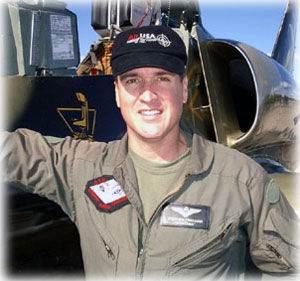
The pilot of the ill
fated flight was
Major Stephen Freeman (Montana) USMC, Retired.
Photograph provided to SitNews
by Dave Riggs of Los Angeles
|
One mobile home was destroyed and a few more may have sustained
damage. Several vehicles in the area also sustained major damage
either from the jet or the debris. There were only minor injuries
on the ground from the fiery crash. The pilot of the jet was
found deceased a short distance away from the crash site.
The legal owner of the aircraft is Air USA of Las Vegas, Nevada
which is a company that provides foreign military aircraft for
aviation enthusiast. The pilot was repossessing the aircraft
on their behalf and was returning it from Anchorage.
News spreads like wildfire in Ketchikan so it's no surprise that
most people have already heard about the tragic accident. In
most cases, newsworthy events involve local residents and as
a result, we know who they are, we recognize their names, or
we at least know their family or friends.
The man who lost his life in our town yesterday was not known
to anyone in Ketchikan. As of Wednesday evening the authorities
had not released the name of the pilot. However, a close friend
of the pilot was contacted and he gave a brief interview by phone
and provided some background information. The pilot's wife had
already been notified of her husband's death.
The pilot of the ill fated
flight was Major Stephen Freeman USMC, Retired. After speaking
with Freeman's friend it became apparent that Ketchikan should
know something about the pilot who lost his life because he may
very well have sacrificed his own to save the lives of some of
our local residents.
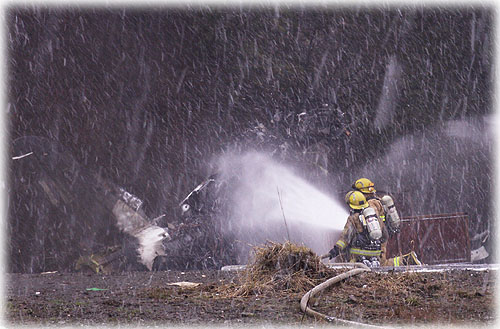 Firefighters man fire
hoses next to the crashed L-39 MS Jet.
Firefighters man fire
hoses next to the crashed L-39 MS Jet.
Photograph by Marie L. Monyak ©2006
Freeman's good friend is Dave Riggs of Los Angeles and the two
had spoken the morning of the crash. Freeman had related to Riggs
that his flight the day before from Anchorage was "real
hairy." He had flown in a snowstorm and his wingman, another
pilot flying alongside Freeman, had lost his gyro, (the control
that enables a pilot to fly and eventually land in poor visibility
conditions). It was Freeman that talked the fellow pilot down
as they flew in formation.
According to Riggs, "Freeman had the experience necessary
to help his fellow pilot because he was a Naval Aviator that
had logged over 2000 hours as an F-18 flight instructor for the
Marine Corp. And you know the Marine Corp, they only allow the
best of the best to be instructors." Riggs added, "Freeman
had also logged over 100 hours flight time on the L-39, the same
jet he flew yesterday. In his career he had logged a total of
3,310 flight hours."
Anyone who's seen the movie Top Gun knows there's a tradition
in which all fighter pilots have nicknames, handles as it were.
Riggs said, "Montana was Steve's [Freeman] handle because
of his accent. As it turns out, Steve was born in Texas, but
the handle Montana just stuck."
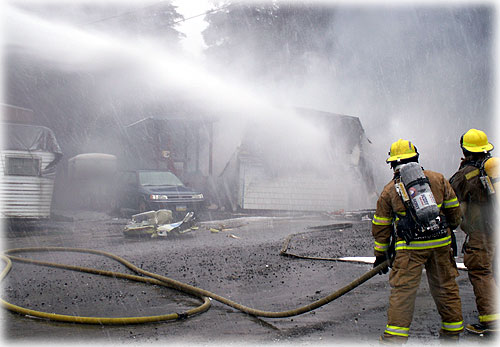
One mobile home was
destroyed and a few more may have sustained damage. Several vehicles
in the area also sustained major damage either from the jet or
the debris. There were only minor injuries on the ground from
the fiery crash.
The second flight seat is visible in this photograph directly
in front of the car.
Photograph by Marie L. Monyak ©2006
Although Freeman worked as a pilot for US Customs, Department
of Homeland Security out of San Diego, California, he enjoyed
taking on extra piloting jobs. Riggs said, "He [Freeman]
was just cast last month to be a fighter pilot in a movie."
"As a pilot, Steve [Freeman] had a positive, can do attitude
but he preached safety and had the courage to make the no-go
weather decision." Riggs said. "Steve left behind a
wife and two infant children. He was a friend, mentor and a terrific
stick"
Sometime before noon on Wednesday, Freeman was flying IFR, (Instrument
Flight Rules) from Sitka to Ketchikan and he had reported to
FAA Flight Services in Ketchikan that he had the airport in sight.
According to a Federal Aviation Adminstration (FAA) spokesperson
in Anchorage, the FAA Flight Service Station in Ketchikan was
contacted by the pilot. According to the FAA, the pilot reported
having the Ketchikan airport's runway in sight and there was
no report by the pilot of any problem. According to the FAA spokesman,
the jet was approaching from the west and was to circle Ketchikan
and land to the west.
The weather report at the time
of the accident was a half mile visibility with a 500 foot ceiling.
There were unconfirmed reports that his landing gear was down.
One witness on the ground said
they saw the jet's canopy blow and separate from the jet. Another
witness thought they saw the jet dumping fuel before the impact.
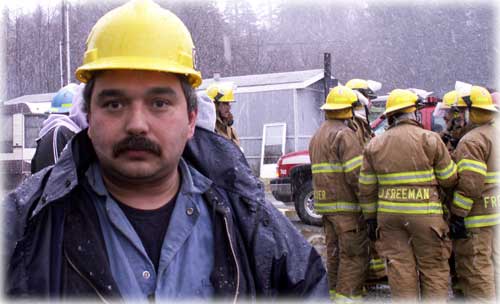
Ed Boone, eyewitness
Photograph by Marie L. Monyak ©2006
Ed Boone of Juneau, who is employed
by Alaska Marine Highway System (AMHS), was on the bow of the
Taku which was tied up across the street from the crash site.
Boone said, "I heard a jet on this side of the boat, land
side, it's not supposed to be there, I heard the engine and saw
the pilot eject and saw the little chute [drogue chute] come
out but the big one didn't."
A witness known only as Dave posted his first hand account on
the internet, "I watched the pilot eject at the last possible
second as he made the plane turn sharply left. In my book he
is a true hero, he could probably saved himself by ejecting earlier
but I watched the man sacrifice his own life to save those of
us that were at the grocery store and all the people working
in the warehouse next door."
Major Freeman ejected at tree level and was found approximately
100 yards from the crash site still strapped in the ejection
seat with the rockets intact and unfired.
Freeman's friend, Dave Riggs concluded that, from all accounts
on the ground, "It appears that the reason for the late
ejection decision may have been because Steve [Freeman] was trying
to direct the plane toward the clear area so no loss of life
on the ground would occur prior to initiating ejection."
From eyewitness accounts, Ketchikan may have been visited by
a true hero yesterday, we'll may never know the whole story.
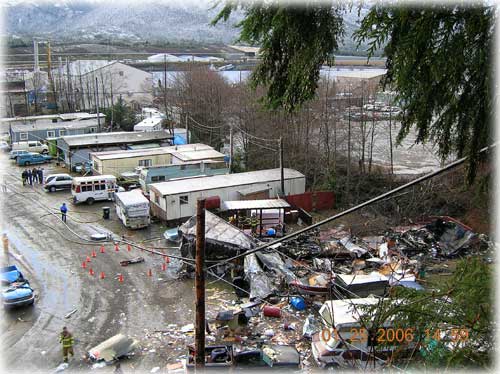 The damage as photographed
later Wednesday afternoon.
The damage as photographed
later Wednesday afternoon.
The Ketchikan Airport can be seen in the distance.
The orange cones circle the second flight seat.
Photograph by Rick Watson ©2006
Over a dozen emergency response teams appeared, some within minutes,
others as needed. There was no shortage of acronyms on North
Tongass and Martin Street; NTVFD, STFVD, KFD, KPD, AST, DEC,
KVRS, KPU, TEMSCO, FAA, NTSB, FBI and the US ARMY.
Dave Martin, Assistant Ketchikan City Manager was designated
as the Public Information Officer (PIO) and briefed the press
with what information was available.
According to Martin, KPU turned off power and telephone service
to the area as Ketchikan Fire Department, North Tongass Volunteer
Fire Department, South Tongass Volunteer Fire department and
Ketchikan Volunteer Rescue Squad worked together to extinguish
fires at both locations: the mobile home which was struck by
the jet and the crash site.
Alaska State Troopers and Ketchikan Police assisted with traffic
control, crowd control, ground search and manned perimeters in
the cold blowing snow.
Until the pilot was found, an all out ground and air search was
conducted. TEMSCO provided two helicopters to assist in the search
while members of the joint fire departments and rescue squad
searched on foot.
The pilot, Major Freeman, was located approximately 100 yards
from the crash site and a portion of the ejection seat still
had unexploded ordinance which was contained by the US Army.
"The City of Ketchikan cancelled Blue Line bus service for
the rest of the day so the bus could be utilized in the evacuation
of residents of the mobile home park," Martin said. "The
Alaska National Guard Armory will be used to temporarily hold
the residents until alternative arrangements can be made at local
hotels."
The Federal Bureau of Investigations and the National Transportation
and Safety Board (NTSB) have secured the crash site to conduct
an investigation into the cause of the accident.
As time goes by and we talk about the day a jet crashed in Ketchikan,
let's remember this man we never got to know - the husband and
father who didn't walk away.
Marie L. Monyak is
a freelance writer living in Ketchikan, Alaska.
Contact Marie at mlmx1@hotmail.com
Contact freelance writers concerning republication fees.
©2006 All rights reserved.
Contact the Editor
Publish A Letter on SitNews Read Letters/Opinions
SitNews
Stories In The News
Ketchikan, Alaska
|





